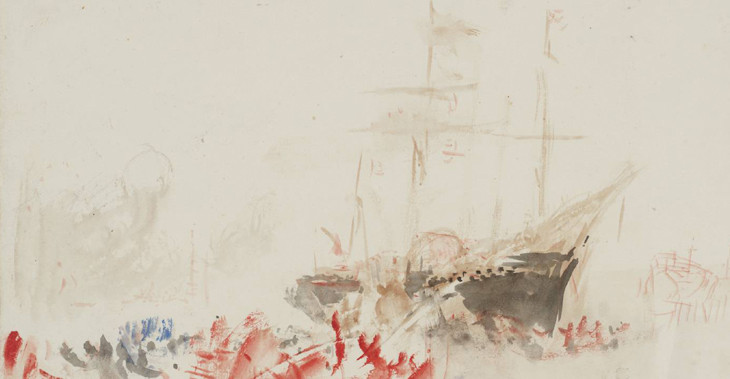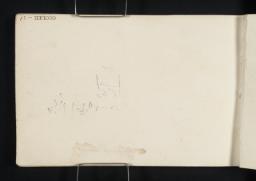From the entry
This small section deals with the events of a single day, Tuesday 8 October 1844, when Louis-Philippe, King of the French, arrived at Portsmouth Harbour in Hampshire, landing at Gosport for an official visit to Queen Victoria from his large hybrid sail-steamship, the Gomer, launched as a French naval frigate in 1841. It includes a small sketchbook (Turner Bequest CCCLXII) apparently used exclusively on that day, and a group of separate studies, mostly in freely handled watercolours, which are likely to be subsequent studio productions. Shortly afterwards, Turner also worked on two large, unfinished oils, now known as The Arrival of Louis-Philippe at the Royal Clarence Yard, Gosport, 8 October 1844 (Tate N02068) and The Disembarkation of Louis-Philippe at the Royal Clarence Yard, Gosport, 8 October 1844 (Tate N04660). Ian Warrell first connected these paintings with Portsmouth in 2003; they had traditionally been considered as showing Venice. He has subsequently considered them in a comprehensive account of the ...
Louis-Philippe at Portsmouth sketchbook 1844
D35685–D35696, D35698–D35700, D35702, D35704, D35706–D35709, D35711–D35719, D35721–D35727, D35729, D35731, D35733, D35735, D35737, D35739, D35741–D35745, D35747–D35749, D35751–D35756, D41236
Turner Bequest CCCLXII 1–37a
D35685–D35696, D35698–D35700, D35702, D35704, D35706–D35709, D35711–D35719, D35721–D35727, D35729, D35731, D35733, D35735, D35737, D35739, D35741–D35745, D35747–D35749, D35751–D35756, D41236
Turner Bequest CCCLXII 1–37a
References
This small section deals with the events of a single day, Tuesday 8 October 1844, when Louis-Philippe, King of the French, arrived at Portsmouth Harbour in Hampshire, landing at Gosport for an official visit to Queen Victoria from his large hybrid sail-steamship, the Gomer, launched as a French naval frigate in 1841.1 It includes a small sketchbook (Turner Bequest CCCLXII) apparently used exclusively on that day, and a group of separate studies, mostly in freely handled watercolours, which are likely to be subsequent studio productions. Shortly afterwards, Turner also worked on two large, unfinished oils, now known as The Arrival of Louis-Philippe at the Royal Clarence Yard, Gosport, 8 October 1844 (Tate N02068)2 and The Disembarkation of Louis-Philippe at the Royal Clarence Yard, Gosport, 8 October 1844 (Tate N04660).3 Ian Warrell first connected these paintings with Portsmouth in 2003; they had traditionally been considered as showing Venice.4 He has subsequently considered them in a comprehensive account of the events of 8 October and their context,5 and the present account is largely a brief summary of his.6
A near-contemporary of Turner’s, Louis-Philippe I (1773–1850) was King of the French from 1830 and 1848, between the revolutions of those years. He had been in exile during the Napoleonic period, spending much time in England where he became a Twickenham neighbour and acquaintance of Turner’s (see the ‘Sandycombe Lodge c.1808–12’ section of this catalogue) at what is now Orleans House, which he revisited in 1844.7 The two had exchanged gifts in the 1830s,8 and in 1845, during his last Continental tour, Turner was invited to the King’s Normandy residence, Château d’Eu, apparently in connection with Queen Victoria’s return visit; see John Chu’s Introduction to his ‘Autumn Tour of Northern France 1845’ section.9 These 1844 and 1845 royal visits were evidence of the closer ties developing between Britain and France at that time, the Queen having first visited Eu in 1843.10 The 1844 arrival at Portsmouth represented the first British appearance of a French monarch for approaching 500 years, and provided an opportunity for the hosts to show suitable pomp and circumstance on a grand scale.11
Unsurprisingly in terms of the importance of his marine subjects, Turner had long-standing familiarity with the setting. See the 1807 Spithead sketchbook (Tate D06520, D06521, D06523, D06546, D06549; Turner Bequest C 3, 4, 6, 27, 30) and the bulk of the 1814 Review at Portsmouth sketchbook (Tate; Turner Bequest CXXXVI), prompted by an earlier display of naval power.12 Perhaps in the summer of 1824, he had conducted a thorough survey of the Portsmouth and Gosport area in the London Bridge and Portsmouth sketchbook (Tate; Turner Bequest CCVI, in the ‘Thames, London and South of England 1821–7’ section of this catalogue), containing many minutely detailed architectural studies which informed various watercolours.
In 1844, Turner had just returned from the last of his late annual visits to Switzerland, and presumably travelled from London to the coast by train to witness the well-publicised occasion; in a letter of 28 December to his friend Francis Hawkesworth Fawkes he recalled that he indeed ‘saw Louis Philippe land at Portsmouth’.13 As noted in the Introduction to the Louis-Philippe at Portsmouth sketchbook, Ian Warrell has observed that Turner ‘was afloat from early in the day, and that he moved around relatively effortlessly, following the course of events as they unfolded, initially from near Southsea Castle, where the French squadron was first saluted, then right up to the Royal Clarence Victualling Yard [now the much changed Royal Clarence Marina], where Louis-Philippe disembarked.’14
Warrell has discussed the subject, dating and technique of the two unfinished oil paintings, concluding that they were in hand for the 1845 Royal Academy exhibition, but remained unfinished for unknown reasons; perhaps Turner had enough to deal with in preparing the four Venetian and two whaling subjects that he showed there,15 and his record of royal patronage, or the lack of it, cannot have been encouraging.16 As noted above, the works’ subject would not be recovered until 2003. In terms of the watercolour studies here, Warrell suggests that Turner’s aim ‘seems not to have been to fix the details in a journalistic fashion. The images are, instead, like variations’ which ‘resist a fixed viewpoint’;17 while this may have been satisfactory to Turner himself and to modern tastes as a personal response, such an approach when extended to the two oil paintings was not conducive to coherent, conventional images for public consumption. James Hamilton has ingeniously suggested that two further whaling paintings with foregrounds crowded with rather overloaded boats, ‘Hurrah! for the Whaler Erebus! Another Fish!’ (Tate N00546)18 and Whalers (Boiling Blubber) Entangled in Flaw Ice, Endeavouring to Extricate Themselves (Tate N00547),19 began as depictions of Louis-Philippe’s arrival, perhaps even in hopes of the King’s patronage, the disappointment of which resulted in their repurposing.20 He has specifically linked one of the ships in Boiling Blubber with the clearest watercolour view of the Gomer (Tate D35981; Turner Bequest CCCLXIV 138).21
More conventional renditions would be supplied by Queen Victoria’s Marine Painter in Ordinary, John Christian Schetky (1778–1874): his The Arrival of His Majesty the King of the French, was shown at the Academy in 1845 (Southampton City Art Gallery),22 and the detailed 1846 painting Débarquement de Louis-Philippe à Portsmouth, le 8 octobre 1844 by Eugène Isabey (1803–1886; Château de Versailles). Tate T12425 is a watercolour of the event by William and John Cantiloe Joy (1803–1867; 1806–1866). A wash drawing attributed to John Wilson Carmichael (1799–1868) or J.C. Joy is at the National Maritime Museum, London, and a watercolour version of the same subject is in the Royal Collection.23 Two National Maritime Museum watercolours by Thomas Sewell Robins (1810–1880) show Portsmouth Harbour with King Louis Philippe’s visit to Queen Victoria, 1844 and a more open view of the French and British squadrons in the Solent, Louis Philippe’s visit to Queen Victoria, October 1844. Passing the flag in Portsmouth Harbour, the latter also being published in France as a lithograph. Another watercolour by Robins shows rowing boats around the moored Gomer,24 with spectators enthusiastically acknowledging the sight by raising their hats while salutes are fired, both points in common with a prominent illustration on the front page of the Illustrated London News for 12 October 1844.
See James Hamilton, ‘“The time must come”: Turner and Royalty’, Turner Society News, no.118, Autumn 2012, p.16 fig.7.
Martin Butlin and Evelyn Joll, The Paintings of J.M.W. Turner, revised ed., New Haven and London 1984, p.297 no.505, pl.506 (colour), as ‘Procession of Boats with Distant Smoke, Venice’, c.1845
See A.J. Finberg, A Complete Inventory of the Drawings of the Turner Bequest, London 1909, vol.I, pp.387–8.
See Warrell 2013, p.9, quoting from John Gage, Collected Correspondence of J.M.W. Turner with an Early Diary and a Memoir by George Jones, Oxford 1980, p.203 letter 275.
How to cite
Matthew Imms, ‘The Arrival of Louis-Philippe, King of the French, at Portsmouth Harbour 1844’, September 2016, in David Blayney Brown (ed.), J.M.W. Turner: Sketchbooks, Drawings and Watercolours, Tate Research Publication, March 2017, https://www



